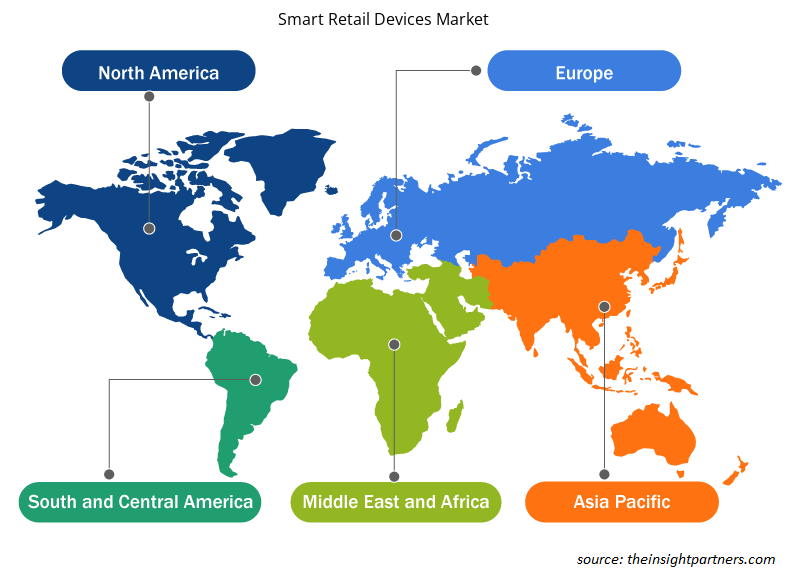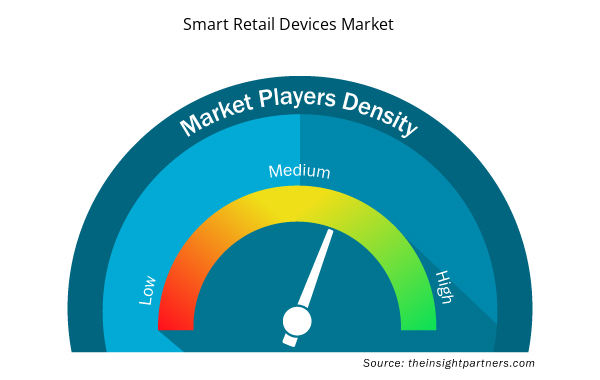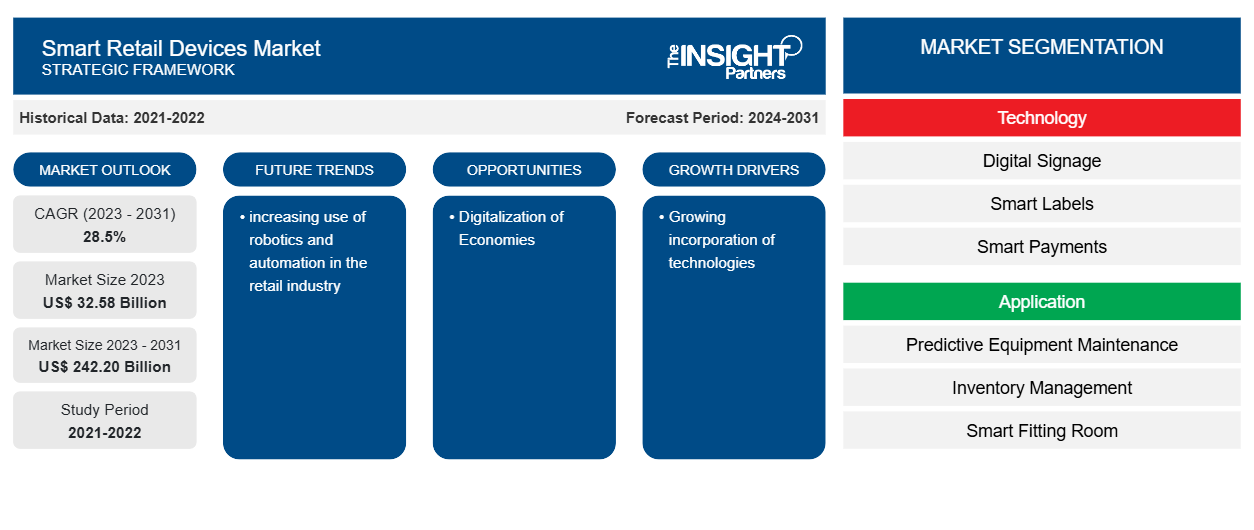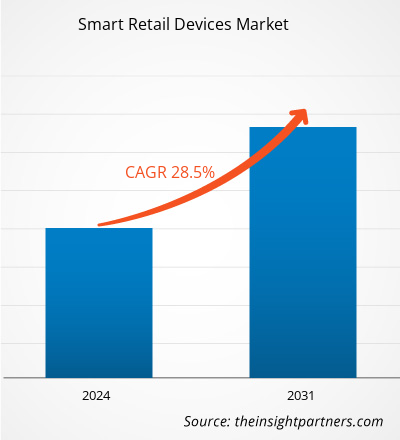Se espera que el tamaño del mercado de dispositivos minoristas inteligentes crezca de US$ 32,58 mil millones en 2023 a US$ 242,20 mil millones en 2031; se anticipa que se expandirá a una CAGR del 28,5% entre 2024 y 2031. Es probable que el uso creciente de la robótica y la automatización en la industria minorista siga siendo una tendencia clave del mercado de dispositivos minoristas inteligentes.CAGR of 28.5% from 2024 to 2031. The increasing use of robotics and automation in the retail industry is likely to remain a key smart retail devices market trends.
Análisis del mercado de dispositivos inteligentes para comercio minorista
La creciente adopción de análisis de big data e Internet de las cosas (IoT) en la industria minorista, junto con el aumento del poder adquisitivo de los consumidores, son los principales factores impulsores del mercado de dispositivos minoristas inteligentes.
Descripción general del mercado de dispositivos inteligentes para comercio minorista
El comercio minorista inteligente es el uso de tecnología y datos para mejorar las experiencias de compra de los clientes y las operaciones de las empresas. Estas tecnologías permiten a las organizaciones mejorar la experiencia del cliente, agilizar los procedimientos y obtener información importante sobre el comportamiento del consumidor. Estos dispositivos conectados a Internet permiten a los usuarios acceder fácilmente a información y servicios personalizados, mientras que las capacidades sofisticadas como el reconocimiento de voz y la integración del panel táctil hacen que las compras sean muy sencillas, con asistentes virtuales que guían a los consumidores para seleccionar los productos adecuados , examinar ofertas interesantes, realizar compras e incluso capturar y compartir experiencias en las redes sociales.
Personalice este informe según sus necesidades
Obtendrá personalización en cualquier informe, sin cargo, incluidas partes de este informe o análisis a nivel de país, paquete de datos de Excel, así como también grandes ofertas y descuentos para empresas emergentes y universidades.
- Obtenga las principales tendencias clave del mercado de este informe.Esta muestra GRATUITA incluirá análisis de datos, desde tendencias del mercado hasta estimaciones y pronósticos.
Impulsores y oportunidades del mercado de dispositivos minoristas inteligentes
Creciente incorporación de tecnologías a favor del Mercado
La integración de tecnologías como la inteligencia artificial (IA), la realidad virtual (RV), la realidad aumentada (RA) y la Internet de las cosas (IdC) se utiliza cada vez más en la industria minorista para mejorar la experiencia de compra, mejorar la gestión de inventarios y agilizar las operaciones de las tiendas. La Internet de las cosas (IdC) es un componente importante en el entorno minorista inteligente porque vincula los dispositivos a Internet y ofrece datos vitales sobre el comportamiento de los clientes, las operaciones de la tienda y la gestión de inventarios. Los dispositivos de la IdC, como los sensores y las balizas, permiten a los comerciantes recopilar datos en tiempo real sobre los niveles de inventario, el flujo de clientes y los activos de la tienda, lo que les permite tomar decisiones más informadas y optimizar las operaciones.
Digitalización de las economías
El uso de la digitalización ofrece varios beneficios a las tiendas, incluida la adquisición de nuevos consumidores y la reducción de los costos operativos. Además, la digitalización tiene la capacidad de incentivar significativamente al personal minorista. Como resultado, los minoristas pueden ver un aumento en sus ingresos. Cabe destacar que las compras fuera de las tiendas experimentaron un crecimiento significativo en el año 2020. Es probable que los puntos de venta minoristas en línea se beneficien enormemente de las mejoras tecnológicas, el aumento de la conexión, la introducción de nuevos sensores y la disponibilidad de soluciones de comunicación fluidas , lo que contribuirá significativamente al crecimiento del mercado durante el período de pronóstico.digitalization provides several benefits to shops, including the acquisition of new consumers and the reduction of operational costs. Additionally, digitization has the ability to significantly encourage retail staff. As a result, retailers may see an increase in their revenues. Notably, non-store shopping witnessed significant growth in the year 2020. Online retail outlets are likely to benefit tremendously from technological improvements, increased connection, the introduction of novel sensors, and the availability of seamless
Análisis de segmentación del informe de mercado de dispositivos minoristas inteligentes
Los segmentos clave que contribuyeron a la derivación del análisis del mercado de dispositivos minoristas inteligentes son la tecnología y la aplicación.
- Según la tecnología, el mercado se divide en señalización digital, etiquetas inteligentes, pagos inteligentes, carritos inteligentes y otros. El segmento de señalización digital tuvo una mayor participación de mercado en 2023.
- En términos de aplicación, el mercado se divide en mantenimiento predictivo de equipos, gestión de inventarios, probadores inteligentes, monitoreo del tráfico peatonal y otros. El segmento de gestión de inventarios tuvo una mayor participación de mercado en 2023.
Análisis de la cuota de mercado de dispositivos inteligentes para comercio minorista por geografía
El alcance geográfico del informe de mercado de dispositivos minoristas inteligentes se divide principalmente en cinco regiones: América del Norte, Asia Pacífico, Europa, Oriente Medio y África, y América del Sur/América del Sur y Central. América del Norte dominó el mercado de dispositivos minoristas inteligentes en 2023. Se espera que esta región sea el principal generador de ingresos en el mercado durante todo el período de tiempo proyectado. El creciente deseo de productos de alta gama y artículos de lujo, junto con los cambios dinámicos en las preferencias de los clientes hacia experiencias minoristas más convenientes y eficientes en el tiempo, son factores importantes que impulsan esta tendencia. Además, la integración generalizada de la tecnología digital en varios sectores está remodelando la economía estadounidense. Las secuelas de la pandemia han acelerado significativamente la transformación digital de las empresas dentro de la industria minorista, superando las expectativas anteriores.
Perspectivas regionales del mercado de dispositivos minoristas inteligentes
Los analistas de Insight Partners explicaron en detalle las tendencias y los factores regionales que influyen en el mercado de dispositivos inteligentes para el comercio minorista durante el período de pronóstico. Esta sección también analiza los segmentos y la geografía del mercado de dispositivos inteligentes para el comercio minorista en América del Norte, Europa, Asia Pacífico, Oriente Medio y África, y América del Sur y Central.

- Obtenga datos regionales específicos para el mercado de dispositivos minoristas inteligentes
Alcance del informe sobre el mercado de dispositivos inteligentes para minoristas
| Atributo del informe | Detalles |
|---|---|
| Tamaño del mercado en 2023 | US$ 32,58 mil millones |
| Tamaño del mercado en 2031 | US$ 242,20 mil millones |
| CAGR global (2023 - 2031) | 28,5% |
| Datos históricos | 2021-2022 |
| Período de pronóstico | 2024-2031 |
| Segmentos cubiertos | Por tecnología
|
| Regions and Countries Covered | North America
|
| Market leaders and key company profiles |
|
Market Players Density: Understanding Its Impact on Business Dynamics
The Smart Retail Devices Market market is growing rapidly, driven by increasing end-user demand due to factors such as evolving consumer preferences, technological advancements, and greater awareness of the product's benefits. As demand rises, businesses are expanding their offerings, innovating to meet consumer needs, and capitalizing on emerging trends, which further fuels market growth.
Market players density refers to the distribution of firms or companies operating within a particular market or industry. It indicates how many competitors (market players) are present in a given market space relative to its size or total market value.
Major Companies operating in the Smart Retail Devices Market are:
- Intel Corporation
- Samsung Group
- NVIDIA CORPORATION
- LG Electronics
- Zebra Technologies Corporation
- Caper Inc.
Disclaimer: The companies listed above are not ranked in any particular order.

- Get the Smart Retail Devices Market top key players overview
Smart Retail Devices Market News and Recent Developments
The smart retail devices market is evaluated by gathering qualitative and quantitative data post primary and secondary research, which includes important corporate publications, association data, and databases. The following is a list of developments in the market:
- In June 2023, Intel and Vericast joined forces to develop, implement, and evaluate a cutting-edge programmable digital in-store retail media network. This innovative system leverages Vericast's advanced targeting technology and Intel's powerful Edge software platforms to deliver personalized advertising and product details that align with the customer's shopping journey. This collaboration is a crucial component of our broader initiative to revolutionize the retail industry and capitalize on the digital transformation of physical stores, which is widely regarded as the next major trend in the advertising sector.
(Source: Intel, Press Release, 2023)
- En noviembre de 2023, Panasonic Connect Europe presentó una nueva solución impulsada por IA que tiene como objetivo transformar la industria minorista al personalizar la publicidad a través de asistentes de IA generativos para los clientes mientras compran. Esta solución innovadora permite a las tiendas monitorear automáticamente la demografía de los compradores y combinar esta información con las preferencias de compra, los datos meteorológicos y los eventos locales para personalizar instantáneamente la publicidad en las pantallas de las tiendas. Panasonic se ha asociado con ADEAL Systems, un especialista líder en datos e IA, para integrar su asistente de compras personal impulsado por IA, CUSAAS (Customer Segmentation As-A-Service), con soluciones de cámaras y pantallas de tecnología minorista de última generación, creando una experiencia de compra mejorada.
(Fuente: Panasonic, Nota de prensa, 2023)
Informe sobre el mercado de dispositivos inteligentes para minoristas: cobertura y resultados
El informe "Tamaño y pronóstico del mercado de dispositivos minoristas inteligentes (2021-2031)" proporciona un análisis detallado del mercado que cubre las siguientes áreas:
- Tamaño del mercado y pronóstico a nivel global, regional y nacional para todos los segmentos clave del mercado cubiertos bajo el alcance
- Dinámica del mercado, como impulsores, restricciones y oportunidades clave
- Principales tendencias futuras
- Análisis detallado de las cinco fuerzas de Porter y PEST y FODA
- Análisis del mercado global y regional que cubre las tendencias clave del mercado, los principales actores, las regulaciones y los desarrollos recientes del mercado.
- Análisis del panorama de la industria y de la competencia que abarca la concentración del mercado, el análisis de mapas de calor, los actores destacados y los desarrollos recientes
- Perfiles detallados de empresas
- Análisis histórico (2 años), año base, pronóstico (7 años) con CAGR
- Análisis PEST y FODA
- Tamaño del mercado Valor/volumen: global, regional, nacional
- Industria y panorama competitivo
- Conjunto de datos de Excel



Report Coverage
Revenue forecast, Company Analysis, Industry landscape, Growth factors, and Trends

Segment Covered
This text is related
to segments covered.

Regional Scope
North America, Europe, Asia Pacific, Middle East & Africa, South & Central America

Country Scope
This text is related
to country scope.
Preguntas frecuentes
The smart retail devices market size is expected to grow from US$ 32.58 billion in 2023 to US$ 242.20 billion by 2031; it is anticipated to expand at a CAGR of 28.5% from 2024 to 2031.
The rising adoption of big data analytics and the Internet of Things (IoT) in the retail industry, the surge in purchasing power of consumers and economic growth are major driving factors for the smart retail devices market.
The increasing use of robotics and automation in the retail industry is likely to remain a key smart retail devices market trends.
The key players holding the majority of shares in the global smart retail devices market are DronaHQ, Salesforce, Thunkable, Inc., WaveMaker, Inc., and Zoho Corporation.
The global smart retail devices market is expected to reach US$ 242.20 billion by 2031.
The Insight Partners performs research in 4 major stages: Data Collection & Secondary Research, Primary Research, Data Analysis and Data Triangulation & Final Review.
- Data Collection and Secondary Research:
As a market research and consulting firm operating from a decade, we have published and advised several client across the globe. First step for any study will start with an assessment of currently available data and insights from existing reports. Further, historical and current market information is collected from Investor Presentations, Annual Reports, SEC Filings, etc., and other information related to company’s performance and market positioning are gathered from Paid Databases (Factiva, Hoovers, and Reuters) and various other publications available in public domain.
Several associations trade associates, technical forums, institutes, societies and organization are accessed to gain technical as well as market related insights through their publications such as research papers, blogs and press releases related to the studies are referred to get cues about the market. Further, white papers, journals, magazines, and other news articles published in last 3 years are scrutinized and analyzed to understand the current market trends.
- Primary Research:
The primarily interview analysis comprise of data obtained from industry participants interview and answers to survey questions gathered by in-house primary team.
For primary research, interviews are conducted with industry experts/CEOs/Marketing Managers/VPs/Subject Matter Experts from both demand and supply side to get a 360-degree view of the market. The primary team conducts several interviews based on the complexity of the markets to understand the various market trends and dynamics which makes research more credible and precise.
A typical research interview fulfils the following functions:
- Provides first-hand information on the market size, market trends, growth trends, competitive landscape, and outlook
- Validates and strengthens in-house secondary research findings
- Develops the analysis team’s expertise and market understanding
Primary research involves email interactions and telephone interviews for each market, category, segment, and sub-segment across geographies. The participants who typically take part in such a process include, but are not limited to:
- Industry participants: VPs, business development managers, market intelligence managers and national sales managers
- Outside experts: Valuation experts, research analysts and key opinion leaders specializing in the electronics and semiconductor industry.
Below is the breakup of our primary respondents by company, designation, and region:

Once we receive the confirmation from primary research sources or primary respondents, we finalize the base year market estimation and forecast the data as per the macroeconomic and microeconomic factors assessed during data collection.
- Data Analysis:
Once data is validated through both secondary as well as primary respondents, we finalize the market estimations by hypothesis formulation and factor analysis at regional and country level.
- Macro-Economic Factor Analysis:
We analyse macroeconomic indicators such the gross domestic product (GDP), increase in the demand for goods and services across industries, technological advancement, regional economic growth, governmental policies, the influence of COVID-19, PEST analysis, and other aspects. This analysis aids in setting benchmarks for various nations/regions and approximating market splits. Additionally, the general trend of the aforementioned components aid in determining the market's development possibilities.
- Country Level Data:
Various factors that are especially aligned to the country are taken into account to determine the market size for a certain area and country, including the presence of vendors, such as headquarters and offices, the country's GDP, demand patterns, and industry growth. To comprehend the market dynamics for the nation, a number of growth variables, inhibitors, application areas, and current market trends are researched. The aforementioned elements aid in determining the country's overall market's growth potential.
- Company Profile:
The “Table of Contents” is formulated by listing and analyzing more than 25 - 30 companies operating in the market ecosystem across geographies. However, we profile only 10 companies as a standard practice in our syndicate reports. These 10 companies comprise leading, emerging, and regional players. Nonetheless, our analysis is not restricted to the 10 listed companies, we also analyze other companies present in the market to develop a holistic view and understand the prevailing trends. The “Company Profiles” section in the report covers key facts, business description, products & services, financial information, SWOT analysis, and key developments. The financial information presented is extracted from the annual reports and official documents of the publicly listed companies. Upon collecting the information for the sections of respective companies, we verify them via various primary sources and then compile the data in respective company profiles. The company level information helps us in deriving the base number as well as in forecasting the market size.
- Developing Base Number:
Aggregation of sales statistics (2020-2022) and macro-economic factor, and other secondary and primary research insights are utilized to arrive at base number and related market shares for 2022. The data gaps are identified in this step and relevant market data is analyzed, collected from paid primary interviews or databases. On finalizing the base year market size, forecasts are developed on the basis of macro-economic, industry and market growth factors and company level analysis.
- Data Triangulation and Final Review:
The market findings and base year market size calculations are validated from supply as well as demand side. Demand side validations are based on macro-economic factor analysis and benchmarks for respective regions and countries. In case of supply side validations, revenues of major companies are estimated (in case not available) based on industry benchmark, approximate number of employees, product portfolio, and primary interviews revenues are gathered. Further revenue from target product/service segment is assessed to avoid overshooting of market statistics. In case of heavy deviations between supply and demand side values, all thes steps are repeated to achieve synchronization.
We follow an iterative model, wherein we share our research findings with Subject Matter Experts (SME’s) and Key Opinion Leaders (KOLs) until consensus view of the market is not formulated – this model negates any drastic deviation in the opinions of experts. Only validated and universally acceptable research findings are quoted in our reports.
We have important check points that we use to validate our research findings – which we call – data triangulation, where we validate the information, we generate from secondary sources with primary interviews and then we re-validate with our internal data bases and Subject matter experts. This comprehensive model enables us to deliver high quality, reliable data in shortest possible time.


 Obtenga una muestra gratuita de este informe
Obtenga una muestra gratuita de este informe